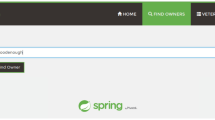Abstract
Legacy systems constitute valuable assets to the organizations that own them, and today, there is an increased demand to make them accessible through the World Wide Web to support e-commerce activities. As a result, the problem of legacy-interface migration is becoming very important. In the context of the CELLEST project, we have developed a new process for migrating legacy user interfaces to web-accessible platforms. Instead of analyzing the application code to extract a model of its structure, the CELLEST process analyzes traces of the system-user interaction to model the behavior of the application's user interface. The produced state-transition model specifies the unique legacy-interface screens (as states) and the possible commands leading from one screen to another (as transitions between the states). The interface screens are identified as clusters of similar-in-appearance snapshots in the recorded trace. Next, the syntax of each transition command is extracted as the pattern shared by all the transition instances found in the trace. This user-interface model is used as the basis for constructing models of the tasks performed by the legacy-application users; these task models are subsequently used to develop new web-accessible interface front ends for executing these tasks. In this paper, we discuss the CELLEST method for reverse engineering a state-transition model of the legacy interface, we illustrate it with examples, we discuss the results of our experimentation with it, and we discuss how this model can be used to support the development of new interface front ends.
Similar content being viewed by others
References
Antoniol, G., Fiutem, R., Merlo, E., and Tonella, P. 1995. Application and user interface migration from basic to visual C++. In Proceedings of the 1995 International Conference on Software Maintenance, Nice, pp. 76–85.
El-Ramly, M., Iglinski, P., Stroulia, E., Sorenson, P., and Matichuk, B. 2001. Modeling the system-user dialog using interaction traces. In Proceedings of the 8th Working Conference on Reverse Engineering, Stuttgart, Germany: IEEE Computer Society Press, pp. 208–217.
El-Ramly, M., Stroulia, E., and Sorenson, P. 2002. From run-time behavior to usage scenarios: An interactionpattern mining approach. In Proceedings of the 8th ACM SIGKDD International Conference on Knowledge Discovery and Data Mining, Canada: Edmonton, AB, pp. 315–324.
Gannod, G., Mudiam, S., and Lindquist, T. 2000. An architectural-based approach for synthesizing and integrating adapters for legacy software. In Proceedings of the 7th Working Conference in Reverse Envineering, Brisbane, Australia, pp. 128–137.
Horowitz, E. 1998. Migrating software to the World Wide Web. IEEE Software, 15(3):18–21.
Kapoor, R.V. and Stroulia, E. 2001. Mathaino: Simultaneous legacy interface migration to multiple platforms. In Proceedings of the 9th International Conference on Human-Computer Interaction, New Orleans, LA, USA, vol. 1, pp. 51–55.
Kieninger, T. 1998. Table structure recognition based on robust block segmentation. In Proceedings of Document Recognition V, SPIE, San Jose, CA, vol. 3305, pp. 22–32.
Kong, L., Stroulia E., and Matichuk B. 1999. Legacy interface migration:Atask-centered approach. In Proceedings of the 8th International Conference on Human-Computer Interaction, Munich, Germany, pp. 1167–1171.
Lewis, C. and Rieman, J. 1993. Task-centered user interface design. http://www.acm.org/perlman/uidesign.html.
Merlo, E., Gagn, P.Y., Girard, J.F., Kontogiannis, K., Hendren, L.J., Panangaden, P., and De Mori, R. 1995. Reverse engineering and reengineering of user interfaces. IEEE Software, 12(1):64–73.
Moore, M., Rugaber, S., and Seaver, P. 1994. Knowledge-based user interface migration. In Proceedings of the 1994 International Conference on Software Maintenance, Victoria, BC, pp. 72–79.
Phanouriou, C. and Abrams, M. 1997. Transforming command-line driven systems to web applications. Computer Networks and ISDN Systems, 29(8–13):1497–1505.
Pressman R. 1996. Software Engineering: A Practitioner's Approach, 4th edn. McGraw-Hill Companies.
Quinlan, J. 1993. C4.5: Programs for Machine Learning. San Mateo, CA: Morgan Kaufmann.
van Rijsbergen, C.J. 1979. Information Retrieval, 2nd edn. London: Butterworths.
Srihari, S., Lam, W., Govindaraju, V., Srihari, R., and Hull, J. 1992. Document image understanding. Tech. Report CEDAR-TR–92–1, Center of Excellence for Document Analysis, State University of New York at Buffalo.
Stroulia, E. and Kapoor, R.V. 2002. Reverse engineering interaction plans for legacy interface migration. In Proceedings of the 4th International Conference on Computer-Aided Design of User Interfaces, Valenciennes, France, pp. 295–310.
Tan, Y.S., Lindquist, D.B., Rowe, T.O., and Hind, J.R. 1998. IBM eNetwork host on-demand: The beginning of a new era for accessing host information in a web environment. IBM Systems Journal, 37(1):133–151.
Tucker, K. and Stirewalt, K. 1999. Model based user-interface reengineering. In Proceedings of the 6th Working Conference on Reverse Engineering, Atlanta, Georgia, pp. 56–63.
Tzerpos, V. and Holt, R. 1999. MoJo: A distance metric for software clustering. In Proceedings of the 6thWorking Conference on Reverse Engineering, Atlanta, Georgia, pp. 187–193.
Author information
Authors and Affiliations
Rights and permissions
About this article
Cite this article
Stroulia, E., El-Ramly, M., Iglinski, P. et al. User Interface Reverse Engineering in Support of Interface Migration to the Web. Automated Software Engineering 10, 271–301 (2003). https://doi.org/10.1023/A:1024460315173
Issue Date:
DOI: https://doi.org/10.1023/A:1024460315173




